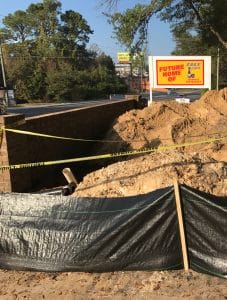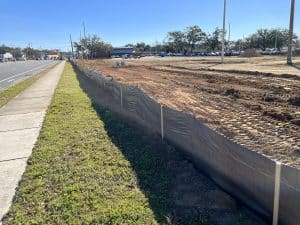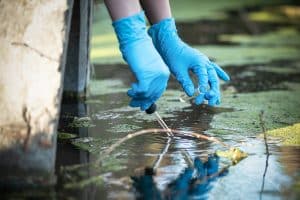Developing a Stormwater Pollution Prevention Plan (SWPPP) in Ohio
Intro
Ohio, known for its diverse range of natural resources and weather conditions, often faces challenges related to stormwater pollution. A crucial step towards preserving Ohio’s water bodies and maintaining a sustainable environment is the development of an effective stormwater pollution prevention plan.
This post guides you through a systematic approach to design a comprehensive plan, covering Ohio’s specific regulations and the essential steps to protect the state’s valuable water resources.
Understanding Stormwater Pollution and its Impact
When rainfall cascades across hard surfaces such as roads, rooftops, and driveways, it often picks up a medley of pollutants. From chemicals and sediments to random litter, all are swept up in the rush, becoming an unwelcome part of our water bodies. This process, known as stormwater pollution, has a profound and harmful impact on both human health and our aquatic environments.
Drinking or coming into contact with polluted water can lead to a host of health issues in humans, ranging from minor illnesses to serious conditions. Equally concerning is the havoc this contaminated water can wreak on our aquatic ecosystems.
Over half of the streams and rivers in Ohio are classified as having moderate to severe habitat impairment due to non-point source pollution like stormwater runoff. (Source: U.S. Geological Survey) It disrupts the delicate balance of life under the water’s surface, causing harm to a diverse range of species.
This grim reality underscores the importance of acknowledging the implications of stormwater pollution.  It’s more than just an environmental issue – it’s a public health concern that impacts every living being that relies on water for survival. By understanding this, we lay the first stone in the path towards building a comprehensive stormwater pollution prevention plan. Together, we can work towards a future where every drop of water in Ohio remains clean and pure.
It’s more than just an environmental issue – it’s a public health concern that impacts every living being that relies on water for survival. By understanding this, we lay the first stone in the path towards building a comprehensive stormwater pollution prevention plan. Together, we can work towards a future where every drop of water in Ohio remains clean and pure.
Grasping Ohio’s Stormwater Pollution Regulations
Ohio’s commitment to preserving its water bodies is evident in its robust regulatory landscape, specifically designed to combat stormwater pollution. Spearheaded by the Ohio Environmental Protection Agency (EPA), these guidelines are a part of the National Pollutant Discharge Elimination System (NPDES).
The crux of these regulations is the requirement of a stormwater pollution prevention plan for any construction site exceeding an acre in size. It’s essential to familiarize yourself with these regulations as their breach could lead to significant penalties.
Understanding and complying with these rules isn’t just about avoiding fines, though. It’s about doing your part to safeguard Ohio’s diverse aquatic ecosystems and the well-being of its residents. After all, every measure taken, every regulation complied with, is a step towards a cleaner, healthier Ohio. So, roll up those sleeves, delve into these guidelines, and get started on your journey to becoming a steward of Ohio’s water resources.
Identifying Potential Pollutant Sources
The path to preventing stormwater pollution begins with finding out where it’s coming from. Embarking on this detective journey requires a comprehensive sweep of your site. You’ll want to locate places that could act as a launchpad for pollutants making their way into the stormwater. Runoff picks up fertilizer, oil, pesticides, dirt, bacteria and other pollutants as it makes its way through storm drains and ditches.
Think storage areas for chemicals, places where waste is disposed of, or areas where vehicles are maintained. Every corner, every nook and cranny counts. But don’t just stop at the immediate environment; widen your lens to consider the bigger picture.
The terrain, climate, and nature of operations taking place on the site can all play a role in where potential pollutants might lurk. In this journey to combat stormwater pollution, understanding the potential sources is like having a roadmap. It pinpoints the critical areas that need your attention, setting the stage for a targeted action plan. So put on your detective hat, carry out a detailed site evaluation, and let’s get started on identifying these potential sources of stormwater pollution.
Implementing Control Measures
With your pollutant sources pinpointed, it’s time to roll out your defenses in the form of control measures. This phase involves leveraging a mix of best management practices (BMPs) and stormwater management strategies. Let’s take a closer look at some of your options.
Silt fences, sediment basins, and vegetation buffers are effective BMPs that help in curbing the flow of pollutants.  These can be supplemented with stormwater management strategies that are more nature-inspired. Consider integrating rain gardens that soak up and filter stormwater, or green roofs that can act as sponges during a downpour.
These can be supplemented with stormwater management strategies that are more nature-inspired. Consider integrating rain gardens that soak up and filter stormwater, or green roofs that can act as sponges during a downpour.
Permeable pavements too, can be a game-changer, allowing rainwater to percolate into the ground instead of rushing off into storm drains with pollutants in tow.
Remember, your battle strategy should be as diverse as the potential sources of pollution you’ve identified. By layering these measures, you not only intercept pollutants before they reach our water bodies, but also contribute to the water cycle by encouraging infiltration where it’s possible. So, suit up and get ready to implement your pollution-fighting measures. This is your moment to make a tangible difference to Ohio’s water resources.
Developing a Stormwater Pollution Prevention Plan
The secret to a robust stormwater prevention plan lies in an effective training program. Knowledge is power, and this couldn’t be truer in the context of stormwater management. An educated team is a powerful asset, capable of executing your prevention plan proficiently. According to the Stormwater Training Center, you have a couple of options to develop your SWPPP. You can either hire a professional company to build the SWPPP for you or you can learn to develop it yourself.
If you decide to develop the SWPPP yourself, here are a couple of important things to keep in mind.
- Start by laying a solid foundation with the basics of stormwater pollution. Ensure that your team understands the severity of this issue, and the pivotal role they play in combating it. It’s imperative that they grasp the relevance of their actions within the larger context of Ohio’s water body preservation efforts.
- Next, get them acquainted with Ohio’s specific regulations. They should be well-versed with the National Pollutant Discharge Elimination System (NPDES) and the Ohio Environmental Protection Agency’s guidelines. This knowledge will empower them to ensure compliance, avoid stormwater violations, and ward off penalties.
- Once they’re familiar with the rules of the game, bring in the details of your on-site measures. Walk them through the control measures you’ve implemented, explaining their function and importance. Dive into the nitty-gritty of the site’s specific potential pollutant sources and the specific measures taken to address them.
- Finally, ensure the learning doesn’t stop. Continuous, periodic training will keep your team updated with the latest practices, paving the way for an ever-evolving, ever-improving stormwater pollution prevention plan.
Completing Regular Inspections and Maintaining Records
Your stormwater prevention plan isn’t a static document gathering dust on a shelf. Instead, consider it a living, breathing guide that thrives on regular checks and updates. These are facilitated through routine inspections that put your plan to the test. Imagine these as mini stress-tests, evaluating the resilience and effectiveness of your pollution control measures.
Does your silt fence still stand strong? Are your rain gardens soaking up stormwater as they should? These checks help you catch any red flags early, nipping potential issues in the bud before they escalate.
But don’t let this critical information evaporate into thin air. Documenting these observations is key. Maintaining meticulous records of your inspections is like preserving snapshots of your plan’s progress over time. These become your trusty sidekicks in demonstrating regulatory compliance and defending against any potential stormwater violations. Plus, they offer a valuable well of information that aids in refining your practices over time.
So, with a sharp eye and a vigilant mindset, embark on your regular inspections. And don’t forget to arm yourself with a sturdy record-keeping system that catalogues your journey towards a pollutant-free Ohio.
Keeping Your Plan Up-to-Date
Think of your stormwater prevention plan as a living organism; it needs to adapt and evolve to stay healthy an

d effective. Changes in your site, operations, or team structure can potentially affect your strategy against stormwater pollution. These shifts might unlock new potential pollutant sources or even render some of your current control measures less effective.
The dynamics of the external environment, too, can demand a refresh. From updated regulatory guidelines to new BMPs emerging in the stormwater management field, the context in which your plan operates is always changing. So, stay ahead of the curve! Regularly review your plan, and don’t hesitate to give it a good shakeup when necessary. Tweaking your strategies, updating your team’s training, or incorporating new technologies and practices could be the revamp your plan needs to stay robust.
Your proactiveness will ensure that your stormwater prevention plan remains a sturdy shield, protecting Ohio’s water bodies from pollution, come what may. So, embrace the fluidity, and let’s keep working towards an ever-evolving, ever-improving stormwater prevention plan for a cleaner, healthier Ohio.

